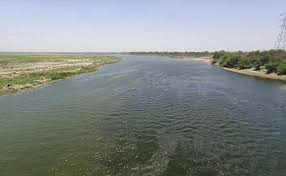Agra. Come Dev Uthani Ekadashi, throngs of devotees will gather along Yamuna’s ghats, their hands filled with prayers yet their hearts loaded with disappointment and despair. The sacred river—once Lord Krishna’s cherished consort, once Mughal Agra’s cooling balm, once a poet’s mirror—now gurgles with stinking foam and black poison, dying a slow, unwept death beneath the shadow of the Taj Mahal.
For four fleeting days during Chhath, water is released from the barrages—ghats glisten, devotees bathe, social media thrills at images of “pristine” Yamuna. But as festivities fade and the gates lock shut, the flow drops—less than nine cumecs, oxygen vanishes, fish turn belly-up. Where once the river’s pulse gave Agra its life, now a toxic tank pulses instead. The Yamuna, gasping beneath the Taj, counts her final breaths—a sacrifice at the altar of apathy.
________________
From Babur’s Ram Bagh to Shah Jahan’s Taj, the Yamuna carved Agra’s soul. Today, it is a river in name only: its fragrance is stench, its current is chemical. Once, the waves brought solace to emperors and inspired lyricists to praise her purity. Now, Yamuna falls victim to negligence, wasting away, inch by wretched inch.
Every year, the pantomime repeats: four days of moonlight, then unending night. Just before Chhath, the Haryana government releases water from Hathni Kund, dressing up Delhi’s ghats for the cameras. This year was no different—6,823 cusecs between October 25 and 28, foam vanishing just long enough for holy selfies. By dusk on the 28th, as Chhath wrapped up, the gates slammed shut, the river’s flow dipping even below the environmental minimum. Four days of performance. Then, the same foul air, the same black poison.
Today, what trickles from Okhla to Agra is little more than a lethal brew—industrial waste, sewage, plastic. Faridabad, Ballabhgarh, Mathura, Vrindavan—each city’s muck flows straight into Yamuna’s veins. “To call this water is a joke,” environmental experts scoff. “This is no river. This is a mobile chemical tank.”
Winter brings less oxygen and more death. Fish float like ghosts, aquatic life is vanishing. Environmentalists call it “festival cleaning”—tokens for the camera, little for the river. Governments treat Yamuna as a seasonal spectacle: flowing for worship, withheld the rest of the year. Yet a river’s right is to flow year-round, not be resurrected for a festival’s selfie session.
Renowned environmentalist Dr. Devashish Bhattacharya notes the irony: “Everyone clamors to save the Taj, but none weep for the river that gives the Taj its mirrored majesty.”
Ten years ago, a minister promised steamers would ply the Yamuna. Today, that promise floats lifeless while the river sinks beneath the waves of broken intent. Billions spent on “Namami Gange” and “Namami Yamuna” projects, yet the Yamuna suffocates in silence.
Politics has also played a criminal conspiratorial role. Haryana, Delhi, Uttar Pradesh—identical parties, zero coordination. The opposition shouts and pickets. Actual action? Nowhere in sight.
On the slain river’s bank, political carnivals persist, echoing only empty announcements—never the sound of flowing water.
Experts insist there’s only one cure: constant, clean flow. Activists of River Connect demand Haryana and Delhi ensure year-round clean water, stop the untreated drains and sewers, dredge the riverbed for groundwater recharge. But Supreme Court orders gather dust; dairies, laundries, truckers, all still dump garbage freely. “Where is river policing?” wonders environmentalist Padmini Iyer. “Open defecation flourishes, laws have become a paper tiger—zero teeth on the ground.”
As for Agra, plans have lingered in the freezer for decades. Says activist Chaturbhuj Tiwari, the barrage scheme is decades old, the celebrated rubber dam project stillborn and stalled. IMA president elect Dr. Harendra Gupta points out: “Had that dam been built, water would stand behind the Taj, Etmad-ud-Daula, and Ram Bagh—restoring the Taj’s shimmering reflection, reviving the city’s spirit.”
The Yamuna today glimmers no longer. Stench rides the air, foam fills the current, bodies and plastic drift on its weary surface. Krishna’s playground only groans in agony.
In the Taj Mahal’s embrace, a dying river waits for someone to listen, for someone—anyone—to wake up.
Governments come and go, slogans change like costumes, but Yamuna’s grief only deepens, year on year.
If honest steps are not taken soon, India’s sacred rivers will exist only in our children’s textbooks, and foul drains will snake through our cities.
Yet, still, the Yamuna cries—
Let me flow.
Let me live.





